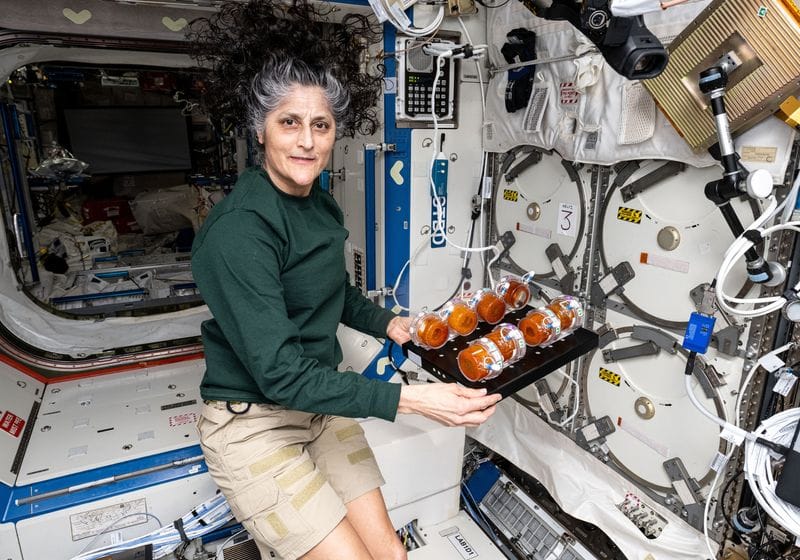Designer Microbes Aid Space Exploration Efforts

In the summer of 2013, NASA’s Curiosity rover celebrated its first birthday inside a dusty red Martian crater, more than 100 million miles away from home. To mark its one-year landing anniversary, scientists programmed Curiosity to vibrate at frequencies corresponding to the notes of the “Happy Birthday” song.
NASA launched the Curiosity rover in November 2011. Since it landed on Mars in August 2012, the rover has obtained important information about the Red Planet’s geochemical properties.
NASA
This lonely birthday celebration drew a deluge of sympathy, with people commenting, “When humans land on Mars, we better…give that rover a hug!” on NASA’s video. More than a decade has elapsed since then, but space agencies have yet to launch a crewed mission to the Red Planet.
“The reason no one has done a human mission to Mars is that it is incredibly difficult to just get the arithmetic to work in terms of bringing enough supplies to support human life for a very long trip,” said Erika debencedistisa molecular biologist and CEO of Pioneer Labs, a startup company engineering biotechnology for space missions. It would take Mars-bound astronauts almost three years for a roundtrip, which is too long for food and drugs to last, requiring crew members to make their own.
Scientists have attempted to tackle this using an innovative approach. “When I was in grad school, the person I did my thesis with would always say, ‘You got to think of what the problem is, and then remember that biology has already solved that problem,’” recalled Frances Donovana biochemist at NASA Ames Research Center. “You just have to go find the biology that solves that problem.”
Erika DeBenedictis, a computational physicist and molecular biologist at Pioneer Labs, engineers microbes to survive on Mars.
Erika debencedistis
Over the past few years, researchers like Donovan and DeBenedictis have done exactly that. They turned to microbes, whose biochemistry enables them to generate nutrients and drugs, as a solution to provide materials for long space travel. However, these organisms and their biochemical pathways have evolved on Earth, so they need to be genetically engineered to biomanufacture materials in conditions like microgravity and higher radiation. Techniques in the field of synthetic biology equip scientists with the means to redesign microbes and tailor them for humans’ extraterrestrial needs.1
A Microscopic Solution for Astronaut Healthcare
At the moment, astronauts carry sterilized and prepackaged food with them during their missions. But the same approach for multi-year deep space exploration missions poses challenges: Though the food may have a long shelf-life, the vital nutrients in it degrade over time. Additionally, researchers estimate that a six-membered crew will have to carry more than 10,000 kilograms of food for a Mars mission.2 But deploying just one kilogram of weight into space costs anywhere between $2,700 and $54,000. So, scientists are working toward replacing a “take” strategy with “make” strategies, where astronauts can produce nutrients in space instead of carrying all of their supplies from Earth.
To meet this need, Donovan and her colleagues have been testing an approach similar to making fermented foods like yogurt and kefir. “This is an age-old process that humans have been using to make and preserve nutrients for themselves,” said Donovan. “And we’ve been doing it in clearly nonsterile conditions for literally close to 10,000 years.”
Frances Donovan, a biochemist at NASA Ames Research Center, designs yeast to produce nutrients on-demand in outer space.
NASA/Brandon Torres Navarrete
In their project called BioNutrients, the researchers used CRISPR-Cas9 to tweak the genes in edible strains of yeast such that they would produce beta-carotene and zeaxanthin, antioxidants usually found in vegetables. In 2019 they launched the modified yeast strains into space, and astronauts aboard the International Space Station (ISS) have been testing the microbes’ shelf life and ability to produce nutrients over time. The experiments require crew members to reconstitute dehydrated yeast with sterile water, incubate the microbes, and then freeze them to be returned to Earth for testing.
Once the astronauts have sufficiently tested the yeast, Donovan hopes that she and her team will be able to send dehydrated pellets to space and astronauts can choose from a buffet of nutrients such as riboflavin, folate, vitamin K, or even caffeine, “Because we’re probably not going to fly coffee trees anytime soon,” she said.
Although they deploy the materials to support microbial growth in space from Earth now, the team hopes that eventually, astronauts will be able to harness local resources available at the mission site, further reducing mission costs. For Mars exploration, this means taking advantage of an atmosphere made up mostly of carbon dioxide, nitrogen, and argon gases.
Scientists at NASA’s Ames Research Center are developing a technology to convert carbon dioxide into organic compounds that can provide media for culturing microbes for biomanufacturing. “So, you genetically engineer (microbes) in two directions,” explained Donovan. “One, to eat a very simple metabolite, and the other, to still produce something of interest at the other end.”
But scientists encountered another challenge: making sure that the engineered microbes can endure the harsh environment on the Red Planet.
Engineering Microbes That Can Survive on Mars
“Mars is a combination of five things we usually use to kill microbes,” said DeBenedictis. The Martian soil contains perchlorate, which is used as a bleaching agent on Earth.3 The planet’s environment is very dry and cold, with temperatures plummeting as low as -153°C (-240°F). The atmosphere there is rich in metal ions that act as antimicrobials on Earth, and it is so thin that it cannot shield the surface from radiation.4,5 Because of this, scientists estimate that an astronaut would receive radiation doses up to 700 times higher on Mars than on Earth.
BioNutrients completed five years of demonstrating technology to produce nutrients on demand aboard the space station. Since vitamins can degrade over time, the investigation used engineered microbes to test generating fresh nutrient supply for future long-duration missions.
NASA
To engineer life for Mars, DeBenedictis and her team recognized the potential of microbes on Earth that have adapted to thrive in extreme environments. “We know of microbes on earth that tolerate each of these conditions independently,” she said.
So, they sought such extremophilesincluding a fungus originally found in Chernobyl that can tolerate radiation, an algal species that grows in snow, and a bacterium that grows in perchlorate. “The work is to figure out how to get those properties into one critter that you can actually use,” explained DeBenedictis.
Last year, the researchers analyzed data collected by Mars landers to characterize the Martian soil composition and create a culture medium to simulate it. Now, they are engineering microbes to thrive in those conditions. “Basically, we need to take this toolkit of microbes that we know how to work with to do manufacturing and upskill them so they don’t die on Mars,” explained DeBenedictis.
To this end, DeBenedictis and her colleagues rely on a method called directed evolution. This approach mimics natural selection to steer proteins, metabolic pathways, or nucleic acids toward a defined goal—in this case, to survive on Mars.6
Their pipeline involves mutating a gene in microbes, selecting the variants that show the desired traits, and iteratively subjecting the microbe to more tweaks until it shows all the required functions. “We’re able to evolve microbes toward this goal of thriving on Mars way faster than they would ever evolve like in nature,” said DeBenedictis.
A preflight image shows BioNutrients-2 Yogurt Bags on a tray, after completing 24hr incubation. The fully-yellow color of the bag’s contents indicates the yogurt has grown to completion.
NASA
However, she noted that engineering microbes to survive space conditions and produce the desired materials is the first step. “Once you have the organisms, the next problem is you have no devices that you can use to grow them in space.”
Donovan and her team have found a simple solution for this. They use fluorinated ethylene propylene pouches containing dehydrated culture medium. A specialized port allows the astronauts to add water and reconstitute the components, offering a feasible way to culture microbes in outer space.
The Future of Space SynBio
Molecular biology reagents must be stored under specific conditions to retain their stability. This requires a continuous power supply, often limiting the deployment of such chemicals for experiments in space. Researchers in the field argue that investing in the development of simple but robust reagents such as stable dried chemicals will accelerate progress in the field.1
Nevertheless, Donovan said the development of CRISPR-Cas9 and advances in sequencing and other technologies have significantly propelled the field forward. “(These techniques) enable us to study extremophiles and gather these novel functions out of the natural world that were hard for us to gain and grasp before,” she said. She added that other scientists at NASA Ames Research Center utilize machine learning-based predictive modeling approaches to design microbes for space exploration. Donovan believes that such advances in the field of synthetic biology are “going to really kind of blow open this field.”
DeBenedictis agreed and noted that the field is at an exciting point with private space stations coming up in the next few years. “As a result, it’s about to get way cheaper to flight test stuff.”
Advances in the field of synthetic biology will solve some of the complex challenges of sending people on long-duration missions like those to Mars. Such progress has, in part, allowed NASA to announce a crewed mission to the Red Planet in the 2030s. However, with this being more than half a decade away, Curiosity may have to wait for its hug from people for a few more years.



